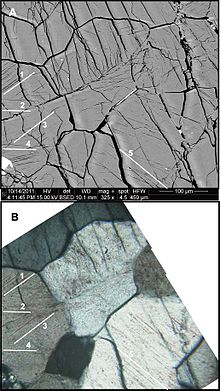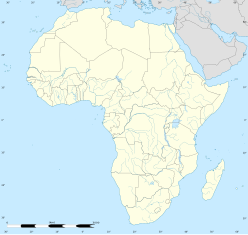Lake Bosumtwi
| Lake Bosumtwi | ||
|---|---|---|
Primary inflows rainfall[2] | | |
| Primary outflows | none[2] | |
| Catchment area | 400 km2 (150 sq mi)[2] | |
| Basin countries | Ghana | |
| Max. length | 8.6 km (5.3 mi) | |
| Max. width | 8.1 km (5.0 mi) | |
| Surface area | 49 km2 (19 sq mi)[2] | |
| Average depth | 45 m (148 ft)[2] | |
| Max. depth | 81 m (266 ft)[2] | |
| Surface elevation | 150 m (490 ft) | |
| References | [2] | |
Lake Bosumtwi is the only natural lake in Ghana. It is situated within an ancient impact crater that is about 10.5 kilometres (6.5 mi) in diameter.[2] It is about 30 km (19 mi) south-east of Kumasi, the capital of Ashanti, and is a popular recreational area. There are about 30 villages near the crater lake of Lake Bosumtwi, with a combined population of about 70,000.[3] The most popular amongst the villages where tourists usually settle is Abono.[4]
The
Impact crater
| Bosumtwi crater | |
|---|---|
| Impact crater/structure | |
| Confidence | Confirmed |
| Diameter | 10.5 km (6.5 mi) |
| Depth |
|
| Age | 1.07 Ma |
| Country | Ghana |

The Lake Bosumtwi impact crater is 10.5 km (6.5 mi) in diameter, slightly larger than the present lake which is approximately 8 km (5.0 mi) across, and is estimated to be 1.07 million years old (Pleistocene period).[1][9]
The depth of crater is approximately 380 m (1,250 ft), but, if counted together with the depth of lake sediments - 750 m (2,460 ft).[10]
The crater has been partly eroded, and is situated in dense rainforest, making it difficult to study and confirm its origin by meteorite impact. Shock features such as shatter cones are largely overgrown by vegetation or covered by the lake. However, drilling of the crater's central uplift beneath the lake floor has recently provided an abundance of shocked materials for scientific study.[9] Tektites, believed to be from this impact, are found in the neighbouring country of Ivory Coast, and related microtektites have been found in deep sea sediments west of the African continent.[9]
A work based on a statistical study of past numerical orbital simulations of the impact event[11] asserts that the possible origin of the impactor is an asteroid coming from the middle main-belt at a high inclination (>17 degrees).[12]
Climate history
Before the asteroid impact, the area was a lush rainforest filled with animals. Following the impact, the resulting crater filled with water forming Lake Bosumtwi.[13]
Periods of heavy
Human history
The legends say that in 1648 an
through the rainforest. Suddenly, the animal disappeared in a small pond. It was as if this body of water wanted to save the animal's life. The hunter never got the antelope, though he settled close to the water and started catching fish. This place he named "Bosomtwe", meaning "antelope god". This story suggests that at that time the lake level was very low. The large dead trees standing offshore in the lake also evidence this, for they are over 300 years old.The following centuries saw several
The Abrodwum Stone is held to be the spiritual centre of the lake. Here, when there is such poor fishing it is considered a bad omen, the lake people
There is a traditional taboo against touching the water with iron and modern boats are not considered appropriate. The padua, a wooden plank requiring considerable skill to maneuver, is the legitimate method. Other taboos such as not washing, bathing or throwing effluents into the Lake that were formerly strictly observed, aided in maintaining the purity and health of the Lake.[4] However, these taboos are not observed by residents or visitors due to their weak implementation by the Abono Traditional Council.
There are current environmental concerns, including overfishing and inadequate farming methods. The growing population increased demand for fish. Excessive fishing led to steadily decreasing catches, forcing increased reliance on agriculture. As more and more of the hills are converted into farmland, exposing the surface to the heavy rainfalls, soil erosion becomes an ever-greater problem. In addition there is the changing lake level. Many villages have been submerged several times forcing the people to move up the slopes or outside the basin. That is the origin of such double names as Pipie No.1 and Pipie No.2.[4]
The lake is a popular
See also
- Lake Iro– another African lake suspected to be an impact crater
References
- ^ a b "Bosumtwi". Earth Impact Database. Planetary and Space Science Centre University of New Brunswick Fredericton. Retrieved 2009-08-12.
- ^ a b c d e f g h "Bosumtwi". LakeNet. Retrieved 2007-02-18.
- ^ "Lake Bosomtwi". touringghana.com. 2016-03-27. Retrieved 2019-06-08.
- ^ ISSN 2344-3219.
- ^ Froese, Rainer; Pauly, Daniel (eds.) (2012). "Hemichromis frempongi" in FishBase. February 2012 version.
- ^ Froese, Rainer; Pauly, Daniel (eds.) (2012). "Tilapia busumana" in FishBase. February 2012 version.
- ^ Froese, Rainer; Pauly, Daniel (eds.) (2012). "Tilapia discolor" in FishBase. February 2012 version.
- ISSN 1945-5100.
- ^ S2CID 6897812.
- ^ "Lake Bosumtwi". Wondermondo. 2013-02-09.
- S2CID 129665903.
- S2CID 118723115.
- ^ Pease, Roland (2004-10-12). "Drilling for Africa's climate history". BBC News. Retrieved 2018-04-02.
- ^ Shanahan et al. 2009
- S2CID 2679216. Retrieved April 2, 2018.
- ^ "Ashanti Academic Showcase". nd.digication.com.
- ^ "Profitability Analysis of all-male Tilapia Farming in Sekyere South and Bosomtwe Districts of Ashanti Region". researchgate.net (PDF). Retrieved 1 August 2015.
- Wolf U. Reimold; Dion Brandt; Christian Koeberl (1998). "Detailed structural analysis of the rim of a large, complex impact crater; Bosumtwi Crater, Ghana". Geology. 26 (6): 543–546. S2CID 7349719.



